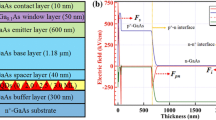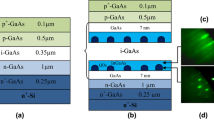Abstract
GaSb/GaAs type-II quantum-dot solar cells (QD SCs) have attracted attention as highly efficient intermediate band SCs due to their infrared absorption. Type-II QDs exhibited a staggered confinement potential, where only holes are strongly confined within the dots. Long wavelength light absorption of the QDSCs is enhanced through the improved carriers number in the IB. The absorption of dots depends on their shape, material quality, and composition. Therefore, the optical properties of the GaSbGaAs QDs before and after thermal treatment are studied. Our intraband studies have shown an extended absorption into the long wavelength region \(1.77 \, \upmu \text {m}\). The annealed QDs have shown significantly more infrared response of \(7.2 \, \upmu \text {m}\) compared to as-grown sample. The photon absorption and hole extraction depend strongly on the thermal annealing process. In this context, emission of holes from localized states in GaSb QDs has been studied using conductance–voltage (G–V ) characteristics.



Similar content being viewed by others
References
A. Luque, A. Martí, Increasing the efficiency of ideal solar cells by photon induced transitions at intermediate levels. J. Phys. Rev. Lett. 78, 5014 (1997)
Y. Okada, N.J. Ekins-Daukes, T. Kita, R. Tamaki, M. Yoshida, A. Pusch, O. Hess, C.C. Phillips, D.J. Farrell, K. Yoshida, N. Ahsan, Y. Shoji, T. Sogabe, J.F. Guillemoles, Intermediate band solar cells: recent progress and future directions. J. Appl. Phys. 2, 021302 (2015)
Zerui Zheng, Haining Ji, Yu. Peng, Zhiming Wang, Recent progress towards quantum dot solar cells with enhanced optical absorption. J. Nanoscale Res. Lett. 11, 266 (2016)
K. Driscoll, M.F. Bennett, S.J. Polly, D.V. Forbes, S.M. Hubbard, Effect of quantum dot position and background doping on the performance of quantum dot enhanced GaAs solar cells. Appl. Phys. Lett. 104, 23119 (2014)
S.J. Polly, S. Hellstroem, M.A. Slocum, Z.S. Bittner, D.V. Forbes, P.J. Roland, R.J. Ellingson, S.M. Hubbard, Effect of electric field on carrier escape mechanisms in quantum dot intermediate band solar cells. J. Appl. Phys. 121, 013101 (2017)
S. Watanabe, S. Asahi, T. Kada, K. Hirao, T. Kaizu, Y. Harada, T. Kita, Two-step photocurrent generation enhanced by miniband formation in InAs/GaAs quantum dot superlattice intermediate band solar cells. J. Appl. Phys. Lett. 110, 193104 (2017)
P.J. Carrington, A.S. Mahajumi, M.C. Wagener, J.R. Botha, Q. Zhuang, A. Krier, Type II GaSb/GaAs quantum dot/ring stacks with extended photoresponse for efficient solarcells. Phys. B 407, 1493–1496 (2012)
Akshay Krishna, Jacob J. Krich, Increasing efficiency in intermediate band solar cells with overlapping absorptions. J. Opt. 18, 7 (2016)
S. Tomic, Effect of Sb induced type II alignment on dynamical processes in InAs/GaAs/GaAsSb quantum dots: implication to solar cell design. J. Appl. Phys. Lett. 103, 072112 (2013)
J. Richter, J. Strassner, T.H. Loeber, H. Fouckhardt, T. Nowozin, L. Bonato, D. Bimberg, D. Braam, A. Lorke, GaSb quantum dots on GaAs with high localization energy of 710 meV and an emission wavelength of 1.3 mm. J. Cryst. Growth 404, 48–53 (2014)
J. Gao, S. Jeong, F. Lin, P.T. Erslev, O.E. Semonin, J.M. Luther, M.C. Beard, Improvement in carrier transport properties by mild thermal annealing of PbS quantum dot solar cells. App. Phys. Lett. 102, 043506 (2013)
W.S. Liu, T.F. Chu, T.H. Huang, Energy band structure tailoring of vertically aligned InAs/GaAsSb quantum dot structure for intermediate band solar cell application by thermal annealing process. J. Opt. Express. 22(25), 30963–74 (2014)
P.M. Lam, J. Wu, S. Hatch, D. Kim, M. Tang, H. Liu, The effect of rapid thermal annealing on InAs/GaAs quantum dot solar cells. J. IET Optoelectron. 9(2), 65–68 (2015)
T. Tayagaki, N. Usami, Y. Kanemitsu, Influence of thermal annealing on the carrier extraction in Ge/Si quantum dot solar cells. J. Appl. Phys. 51 (2012)
J. Wu, Z.M. Wang, V.G. Dorogan, S. Li, J. Lee, Y.I. Mazur, E.S. Kim, G.J. Salamo, Effects of rapid thermal annealing on the optical properties of strain-free quantum ring solar cells. J. Nanoscale Res. Lett. 8(1), 5 (2013)
W.H. Chang, W.Y. Chen, M.C. Cheng, C.Y. Lai, T.M. Hsu, N.T. Yeh, J.I. Chyi, Charging of embedded InAs self-assembled quantum dots by space-charge techniques. J. Phys. Rev. B 64, 125315 (2001)
I. Ramiro, J. Villa, C. Tablero, E. Antolín, A. Luque, A. Martí, J. Hwang, J. Phillips, A.J. Martin, J. Millunchick, Analysis of the intermediate-band absorption properties of type-II GaSb/GaAs quantum-dot photovoltaics. J. Phys. Rev. B 96, 125422 (2017)
H. Boustanji, S. Jaziri, J.L. Lazzari, Contribution of a single quantum dots layer in intermediate band solar cells: a capacitance analysis. Sol. Energy Mater. Sol. Cells 159, 633–639 (2017)
W.S. Liu, R.Y. Liu, HCh. Lin, Tailoring energy band alignment of vertically aligned InGaAs quantum dots capped with GaAs(Sb)/AlGaAsSb composite structure after thermal annealing treatment. J. ACS Photon. 4(2), 242–250 (2017)
T. Kawazu, H. Sakaki, Effects of interface grading on electronic states and optical transitions in GaSb type-II quantum dots in GaAs. J. Appl. Phys. 50, 04DJ06 (2011)
N. Vukmirovic, Z. Gacevic, Z. Ikonic, D. Indjin, P. Harrison, V. Milanovic, Intraband absorption in InAs/GaAs quantum dot infrared photodetectorseffective mass versus K.P modeling. Semicond. Sci. Technol. 21, 1098–1104 (2006)
D.E. Maghraoui, M. Triki, S. Jaziri, M. Leroux, J. Brault, Quasi-bound states and continuum absorption background of polar Al0.5Ga0.5N/GaN quantum dots. J. Appl. Phys. 116, 014301 (2014)
W. Ng, E. Zibik, L. Wilson, M. Skolnick, J. Cockburn, M. Steer, Tuning of intraband absorption and photoresponse in self-assembled InAs/GaAs quantum dots by thermal annealing. J. Appl. Phys. 103, 066101 (2008)
M. Sabaeian, M. Shahzadeh, Investigation of in-plane and z-polarized intersubband transitions in pyramid-shaped InAs/GaAs quantum dots coupled to wetting layer: size and shape matter. J. Appl. Phys. 116, 043102 (2014)
T.A. Ameen, Y.M. El Batawy, Polarization dependence of absorption by bound electrons in self-assembled quantum dots. J. Appl. Phys. 113, 193102 (2013)
J. Houel, S. Sauvage, A. Lemaitre, P. Boucaud, Interference effects on bound-to-continuum quantum dot absorption. J. Appl. Phys. 107, 083102 (2010)
J.Z. Zhang, I. Galbraith, Intraband absorption for InAs/GaAs quantum dot infrared photodetectors. Appl. Phys. Lett. 84, 1934 (2004)
T. Kawazu, H. Sakaki, Effects of Sb/As intermixing on optical properties of GaSb type-II quantum dots in GaAs grown by droplet epitaxy. App. Phys. Lett. 97, 261906 (2010)
A. Sellai, P. Kruszewski, A. Mesli, A.R. Peaker, M. Missous, Electrical characteristics of InAs self-assembled quantum dots embedded in GaAs using admittance spectroscopy. J. Nanophoton. 6, 063502–0635031 (2012)
Author information
Authors and Affiliations
Corresponding author
Appendix conductance–voltage (G–V)characteristics of self-assembled quantum dots
Appendix conductance–voltage (G–V)characteristics of self-assembled quantum dots
Under the thermodynamic equilibrium state \(\displaystyle \frac{ \text {d}{P_{\text {QD}}(t)} }{ \text {d }t }=0\) we have, [14]
we define the equilibrium occupation fraction by \(f_{\text {h}}^{\text {eq}}\), which is given by \(f_{\text {p}}^{\text {eq}}=\displaystyle \frac{P_{\text {QD}}}{N_{\text {QD}}}\)
For a small perturbation at a given angular frequency \(\omega =2{\varPi }f\), the variation of population is given to first order by
where \(j=\sqrt{-1}\), we obtain for \(\delta p=p \displaystyle \frac{e\delta \varphi _{\text {con}}}{K_{\text {B}}T}\) and \(\delta \varphi _{\text {con}}\) represents the potential difference at the GaSb QDs layer caused by the applied ac bias. Then, we can write the change of population as follows:
For a device with surface S the small applied voltage causes the modulation of the charge will fill and empty the GaSb QD levels, which will induce an ac current defined as \(\delta I=S_{\text {p}} e \displaystyle \frac{ \text {d}\delta {P_{\text {QD}}(t)} }{ \text {d }t }\)
By taking the real part of \((\displaystyle \frac{\delta I}{\delta V})\) we can determine the QD conductance G, which can be written by
where \(\tau =\displaystyle \frac{(1-f_{\text {p}}^{\text {eq}})}{e_{\text {p}}^{\text {th}}}\), \(\alpha =S_{\text {p}} q^{2}N_{\text {QD}}\beta\) and \(\beta =\displaystyle \frac{\delta \varphi _{\text {conf}}}{\delta V}\). We can note from the last expression the function \(f_{\text {p}}^{\text {eq}}(1-f_{\text {p}}^{\text {eq}})\) shows a peak when \(f_{\text {p}}^{\text {eq}}= \displaystyle \frac{1}{2}\) and the term \(\displaystyle \frac{\omega ^{2}\tau }{1+\omega ^{2}\tau ^{2}}\) has a maximum value when \(\omega \tau =1=2e_{\text {p}}.\)
Rights and permissions
About this article
Cite this article
Boustanji, H., Jaziri, S. Type-II GaSb/GaAs quantum-dot intermediate band with extended optical absorption range for efficient solar cells. Appl. Phys. A 124, 121 (2018). https://doi.org/10.1007/s00339-017-1495-z
Received:
Accepted:
Published:
DOI: https://doi.org/10.1007/s00339-017-1495-z




